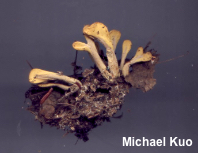| Major Groups > Clubs & Corals / Oddballs & Misfits > Spathularia flavida |

|
Spathularia flavida [ Ascomycota > Rhytismatales > Cudoniaceae > Spathularia ... ] by Michael Kuo This funky, spatula-shaped mushroom features a flattened, two-dimensional head portion that surrounds the top of the stem like a corona. It is separated from the similar Spathulariopsis velutipes by virtue of its smooth (rather than finely velvety), paler stem and its yellower colors overall. Spathularia flavida appears in conifer forests, where it tends to grow in clusters in needle duff. Spathularia flavida was originally described from Europe, where it is widespread. In North America it is recognized from northern and montane locations—but whether our version (or versions) of the species are the same as the European species is unclear. Several North American varieties have been described, although they are often treated as synonyms of Spathularia flavida. One Rocky Mountain version of the species, Spathularia flavida var. ramosa, seems clearly distinct to me; it consistently features an irregularly-club-shaped, less two-dimensional head and dull orangish yellow colors. Description: Ecology: Presumably saprobic; growing gregariously or in clusters under conifers in needle duff; summer and fall; northern and montane North America; widespread in Europe. The illustrated and described collections are from Michigan and Italy. Fruiting Body: Roughly spatula-shaped, with a flattened head portion at the top of a stem, usually running down the stem on either side of it. Head 15–25 mm across; 20–30 mm high; clear, pale yellow; bald and often slightly wrinkled; moist when fresh. Stem 25–40 x 4–8 mm; more or less equal; bald; whitish; becoming hollow; attached to whitish mycelium. Flesh insubstantial; somewhat rubbery; yellowish. Odor not distinctive. Microscopic Features: Spores 30–75 x 1–3 µm; aciculate; often slightly curved; smooth; hyaline and multiguttulate in KOH. Asci 60–110 x 8–10 µm; fusiform; hyaline in KOH. Paraphyses 60–130 x 1–4 µm; cylindric; flexuous; apices rounded or subclavate; often curving, hooking, or curling past the asci—sometimes dramatically so, creating a tangled mass of hyphae appressed to the hymenial surface; smooth; hyaline in KOH. REFERENCES: Persoon, 1797. (Fries, 1821; Saccardo, 1889; Mains, 1955; Guzmán et al., 1980; Smith, Smith & Weber, 1981; Breitenbach & Kränzlin, 1984; Arora, 1986; Barron, 1999; Wang et al., 2002; Kibby, 2006; McNeil, 2006; Trudell & Ammirati, 2009; Raymundo et al., 2012; Alcántara, 2014; Beug et al., 2014; Ge et al., 2014; Woehrel & Light, 2017.) Herb. Kuo 09080101, 10141406. This site contains no information about the edibility or toxicity of mushrooms. |
© MushroomExpert.Com |
|
Cite this page as: Kuo, M. (2019, April). Spathularia flavida. Retrieved from the MushroomExpert.Com Web site: http://www.mushroomexpert.com/spathularia_flavida.html |






